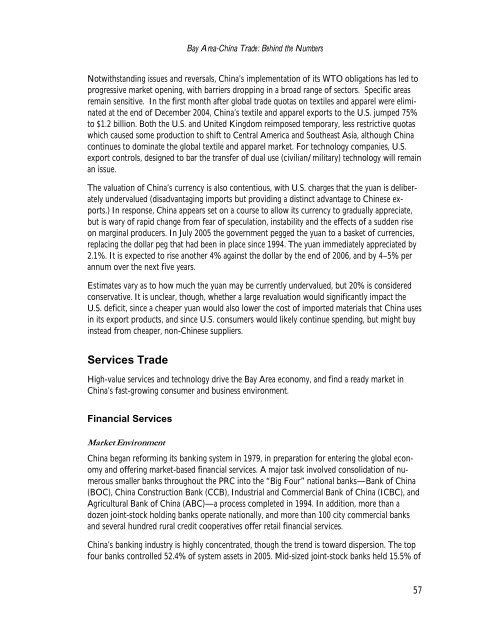Ties That Bind - Bay Area Council Economic Institute
Ties That Bind - Bay Area Council Economic Institute
Ties That Bind - Bay Area Council Economic Institute
Create successful ePaper yourself
Turn your PDF publications into a flip-book with our unique Google optimized e-Paper software.
<strong>Bay</strong> <strong>Area</strong>-China Trade: Behind the Numbers<br />
Notwithstanding issues and reversals, China’s implementation of its WTO obligations has led to<br />
progressive market opening, with barriers dropping in a broad range of sectors. Specific areas<br />
remain sensitive. In the first month after global trade quotas on textiles and apparel were eliminated<br />
at the end of December 2004, China’s textile and apparel exports to the U.S. jumped 75%<br />
to $1.2 billion. Both the U.S. and United Kingdom reimposed temporary, less restrictive quotas<br />
which caused some production to shift to Central America and Southeast Asia, although China<br />
continues to dominate the global textile and apparel market. For technology companies, U.S.<br />
export controls, designed to bar the transfer of dual use (civilian/military) technology will remain<br />
an issue.<br />
The valuation of China’s currency is also contentious, with U.S. charges that the yuan is deliberately<br />
undervalued (disadvantaging imports but providing a distinct advantage to Chinese exports.)<br />
In response, China appears set on a course to allow its currency to gradually appreciate,<br />
but is wary of rapid change from fear of speculation, instability and the effects of a sudden rise<br />
on marginal producers. In July 2005 the government pegged the yuan to a basket of currencies,<br />
replacing the dollar peg that had been in place since 1994. The yuan immediately appreciated by<br />
2.1%. It is expected to rise another 4% against the dollar by the end of 2006, and by 4–5% per<br />
annum over the next five years.<br />
Estimates vary as to how much the yuan may be currently undervalued, but 20% is considered<br />
conservative. It is unclear, though, whether a large revaluation would significantly impact the<br />
U.S. deficit, since a cheaper yuan would also lower the cost of imported materials that China uses<br />
in its export products, and since U.S. consumers would likely continue spending, but might buy<br />
instead from cheaper, non-Chinese suppliers.<br />
Services Trade<br />
High-value services and technology drive the <strong>Bay</strong> <strong>Area</strong> economy, and find a ready market in<br />
China’s fast-growing consumer and business environment.<br />
Financial Services<br />
0DUNHW (QYLURQPHQW<br />
China began reforming its banking system in 1979, in preparation for entering the global economy<br />
and offering market-based financial services. A major task involved consolidation of numerous<br />
smaller banks throughout the PRC into the “Big Four” national banks—Bank of China<br />
(BOC), China Construction Bank (CCB), Industrial and Commercial Bank of China (ICBC), and<br />
Agricultural Bank of China (ABC)—a process completed in 1994. In addition, more than a<br />
dozen joint-stock holding banks operate nationally, and more than 100 city commercial banks<br />
and several hundred rural credit cooperatives offer retail financial services.<br />
China’s banking industry is highly concentrated, though the trend is toward dispersion. The top<br />
four banks controlled 52.4% of system assets in 2005. Mid-sized joint-stock banks held 15.5% of<br />
57








